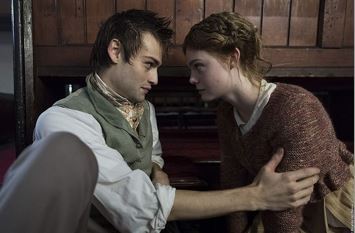This Halloween season, Frankenstein is everywhere. And no wonder, for the book turned 200 this year and is overdue for a party. While the monster is everywhere, what about the woman who created the famous story? We’ve asked our own Frankenstein expert and Curator of Science Fiction and Popular Culture, Peter Balestrieri to review the latest film on the famed female author.
Review of Mary Shelley, from Peter Balestrieri
In 2018, the 200th anniversary of the publication of Mary Shelley’s Frankenstein, a new film by director, Haifaa Al-Mansour, Mary Shelley, opened and died quietly. Not the subject, writing, direction, nor the talent and reputations of its stars could save it. I saw it and enjoyed it very much. I anxiously waited for this film after it went into production and hoped it could do justice to its subject and the Romantic period. It comes not long after a recent biopic of doomed John Keats, and, featuring doomed Percy Bysshe Shelley, doomed Lord Byron, and doomed John Polidori, along with possibly the greatest teenage author ever, Mary Shelley, it promised to be a welcome addition to all the scholarly and pop culture attention focused on Frankenstein. Alas, it bombed.
Some critics panned the film for deviating from historical fact; it is actually very close to the mark with a few notable exceptions. Some have objected to the acting; it was certainly good enough, with Elle Fanning doing a wonderful job, proving again that she is one of film’s best young talents. Familiar faces from Game of Thrones and BBC productions round out the cast. Most reviewers agree Mary Shelley is a very good film to look at; I thought so too, especially the costumes and interior shots. Also good: the dialog, both sharp and poetic. For me, though, one feature more than any other makes this a film worth seeing for anyone interested in the period, the subject, the personalities involved: the troubled, complex relationship between Mary and Percy.
I began research into Frankenstein years ago, using materials from Special Collections and Shelley biographies and it was Mary’s story that impressed me the most. I think Mary put much of her pain and frustration with Percy and his treatment of her into the novel, writing Percy as Victor Frankenstein and herself as the Creature. The film goes into this territory in a way unseen before and I loved it. Percy Shelley is a Bad Boy, who, along with Byron and others, creates the lifestyle emblematic of the Romantics, doomed libertine artists who blaze comet-like and are gone too soon. When Mary rejects her husband’s hypocrisy, cruelty, and excess, the film sends a powerful message to young women and men. See Mary Shelley if you get the chance. I will definitely be seeing it again. It is, however, not a good Halloween film; the only monsters in Mary Shelley are the people in her life.
